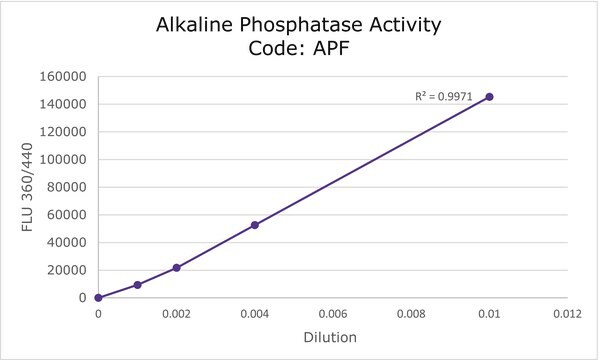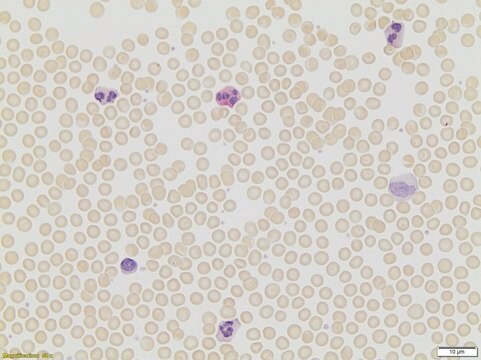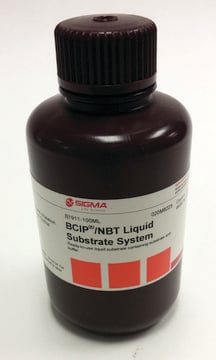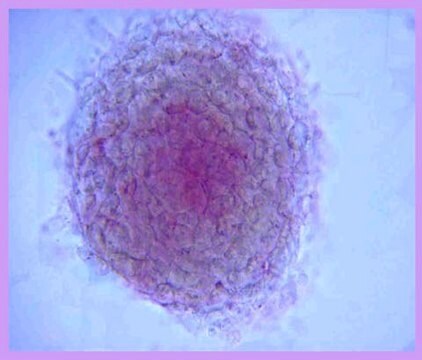SCR066
Quantitative Alkaline Phosphatase ES Characterization Kit
This Quantitative Alkaline Phosphatase Embryonic Stem (ES) Characterization Kit easily quantifies the amount of alkaline phosphatase present within their embryonic stem cell cultures using a convenient 96-well colorimetric enzymatic assay.
About This Item
おすすめの製品
品質水準
交差性(ホモロジーによる予測)
mammals
メーカー/製品名
Chemicon®
テクニック
cell culture | stem cell: suitable
入力
sample type: human embryonic stem cell(s)
sample type cardiac stem cell(s)
sample type neural stem cell(s)
sample type hematopoietic stem cell(s)
sample type epithelial cells
sample type mesenchymal stem cell(s)
sample type pancreatic stem cell(s)
sample type: mouse embryonic stem cell(s)
sample type induced pluripotent stem cell(s)
詳細
Alkaline phosphatase (ALP) is a hydrolase enzyme responsible for dephosphorylating molecules such as nucleotides, proteins, and alkaloids under alkaline conditions. The enzyme is present within all tissues of the body but is elevated in cells of the liver, kidney, bone, placenta, embryo and under specific disease states. Under alkaline conditions (pH>10), ALP can catalyze the hydrolysis of p-nitrophenylphosphate (p-NPP) into phosphate and p-nitrophenol, a yellow colored by-product of the catalytic reaction. The amount of p-nitrophenol produced is proportional to the amount of alkaline phosphatase present within the reaction. The amount of ALP can thus be reliably quantified by reading the amount of p-nitrophenol amassed after the catalytic reaction at 405 nm on a spectrophotometer.
アプリケーション
幹細胞研究
構成
p-NPP Buffer: (Part No. ES011-10ML) 10 mL
Reaction Stop Solution: (Part No.CS200653) 5 mL
1X Wash Solution: (Part No. CS200652) 2 X 125 mL
Recombinant Alkaline Phosphatase Standard: (Part No. CS200654) 0.5 μg (10 μg/mL)
保管および安定性
法的情報
免責事項
シグナルワード
Danger
危険有害性情報
危険有害性の分類
Aquatic Chronic 3 - Eye Dam. 1 - Met. Corr. 1 - Repr. 2 - Skin Corr. 1B
保管分類コード
8A - Combustible corrosive hazardous materials
適用法令
試験研究用途を考慮した関連法令を主に挙げております。化学物質以外については、一部の情報のみ提供しています。 製品を安全かつ合法的に使用することは、使用者の義務です。最新情報により修正される場合があります。WEBの反映には時間を要することがあるため、適宜SDSをご参照ください。
毒物及び劇物取締法
キットコンポーネントの情報を参照してください
PRTR
キットコンポーネントの情報を参照してください
消防法
キットコンポーネントの情報を参照してください
労働安全衛生法名称等を表示すべき危険物及び有害物
キットコンポーネントの情報を参照してください
労働安全衛生法名称等を通知すべき危険物及び有害物
キットコンポーネントの情報を参照してください
カルタヘナ法
キットコンポーネントの情報を参照してください
Jan Code
キットコンポーネントの情報を参照してください
試験成績書(COA)
製品のロット番号・バッチ番号を入力して、試験成績書(COA) を検索できます。ロット番号・バッチ番号は、製品ラベルに「Lot」または「Batch」に続いて記載されています。
ライフサイエンス、有機合成、材料科学、クロマトグラフィー、分析など、あらゆる分野の研究に経験のあるメンバーがおります。.
製品に関するお問い合わせはこちら(テクニカルサービス)









